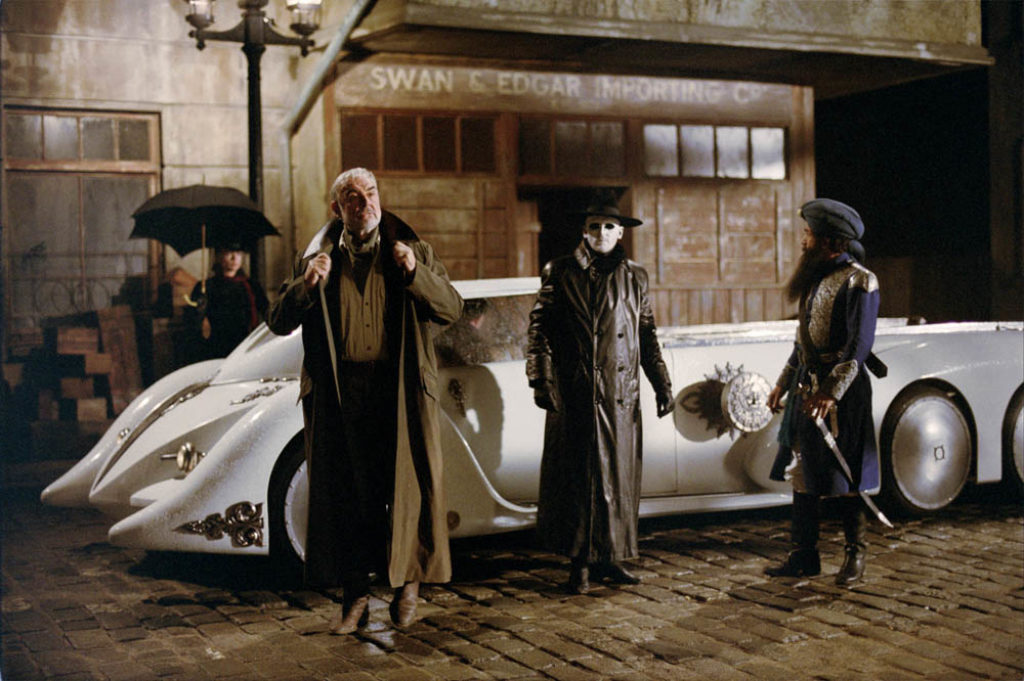
On the eve of the 20th century, classic characters from literature are recruited to thwart a megalomaniac ready to light the fuse on global war. The senior member of this erudite Justice League, African explorer/adventurer Allan Quatermain, is joined by the gun-slinging Tom Sawyer, an invisible man named Skinner, eccentric Indian inventor Captain Nemo, the immortal and hedonistic Dorian Gray and a blood-sucking female vampire named Mina. Also on board is Dr. Jekyll, who must rein in his Hulk-like alter-ego until there’s a need for the brute strength of Mr. Hyde. Based on a series of graphic novels by Alan Moore, this effects-heavy action film imagines what would happen if they all climbed into the Nautilus and traversed the globe on a joint mission … with a traitor in their midst. [Warning: some spoilers revealed]
positive elements: Each of the flawed personalities in this so-called League of Extraordinary Gentlemen needs personal redemption. Most find it through teamwork and self-sacrifice. Nemo refers to his pirate days and high-seas larceny as “old wrongs.” Quatermain confesses to vanity, pride and a history of costly mistakes (he atones for them by “adopting” Sawyer and saving his life at personal risk). To save the submarine and its crew, Dr. Jekyll willingly enters what could be a watery grave. Bad guys’ greed and lust for power ends in their destruction, both at personal and corporate levels. At a time before civil rights and racial equality, Quatermain makes it a point to say of his dangerous lifestyle, “I’ve lost friends-white men and black.” Dr. Jekyll’s internal struggle demonstrates the virtue of and need for self-control. When he realizes that his transformation serum has been stolen by the enemy, he’ll do whatever it takes to keep society from reaping the whirlwind (“I will not let my evil infect the world”).
spiritual content: An African witch doctor performs a ritual over a grave, and it is implied that the person will be resurrected. Capt. Nemo kneels before a statue of Kali, the Indian god of death (Mina asks if it’s wise to go into battle with a man who “worships death”). Quatermain says that a witch doctor blessed him once and told him that Africa would never let him die. Crosses mark graves on the veldt.
sexual content: The smoldering sensuality inherent to vampire lore surrounds Mina. That includes sexualized violence. Her identity is first revealed when she turns on an attacker and feasts on his neck, wiping blood from her mouth and licking her lips in ecstasy. In spite of witnessing this display, the men in the group vie for her affection. Dorian Gray has a sexual history with Mina. They kiss before eventually squaring off in a battle of immortals. Their vicious engagement is set in a bedroom, which leads to some very modern innuendo. The invisible Skinner touches Mina inappropriately and jokes about frostbitten body parts and the fact that he’s naked.
violent content: The action violence is so incessant that it’s numbing. It’s impossible to detail all of it. Machine-gunfire, explosions, knife fights, fist fights, sword fights and more. Men are stabbed or shot at close range. Some have their necks snapped. One hero takes a dagger in the back. Quatermain impales a man on a mounted rhino’s horn (it goes in his back and comes out his chest). When Gray is riddled with bullets, his wounds heal automatically, but other victims aren’t so lucky. The bodies really pile up. A man is engulfed by a blowtorch. Mr. Hyde tosses men around like rag dolls, and is contorted painfully as he’s transformed back to Henry Jekyll. A policeman is run down by a tank. A man holding a knife to Mina’s throat has the tables turned when she goes for his throat, killing him and sucking his blood. The city of Venice endures widespread destruction. A man is quickly reduced to an emaciated skeleton. A duel between Gray and Mina finds each stabbing each other with swords. When a villain gulps down Jekyll’s formula, he turns into an über-Hyde who creates a swath of destruction, and prepares to stab people with a giant icicle before being crushed to death. He and Hyde go at it in a battle of gargantuans. Mina and her swarm of bats attack men firing on them from rooftops.
crude or profane language: The film’s 17 abuses of language include several exclamatory uses of God’s name (“my g–“), mild profanities (“d–n,” “h—“) and a half-dozen uses of the expression “bloody.”
drug and alcohol content: Men drink alcohol in a bar/social club. Gray sips from a flask.
conclusion: What we have here is a bunch of quasi-heroic Victorian literary characters who’ve been thrust into a very busy, very violent action movie and forced to adopt all the postmodern traits needed for that context. I can’t help but wonder what Oscar Wilde, H. Rider Haggard, H.G. Wells, Mark Twain, Bram Stoker, Jules Verne and Robert Louis Stevenson would think of someone turning their beloved creations into a pulpy excuse to blow stuff up. Granted, the revisionism began with Alan Moore’s graphic novel, but the whole thing feels rather exploitative. Is it entertaining? At times, especially when these tragic heroes allude to their origins and discuss their need to slay personal demons. It lends some humanity to a lot of wild chases and absurd special effects (is it logical to think that Nemo’s enormous sub was submerged 40 stories deep right alongside a London dock?). This quirky genre-bending popcorn flick isn’t a complete disaster on the level of Wild Wild West or Hudson Hawk, but it’s not likely to spawn a franchise, either. Personal taste aside, there’s just too much violence—some sexualized—to put a stamp of approval on The League of Extraordinary Gentlemen.